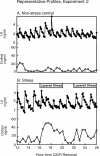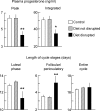The estrous cycle of the ewe is resistant to disruption by repeated, acute psychosocial stress
- PMID: 20164438
- PMCID: PMC2874503
- DOI: 10.1095/biolreprod.109.078774
The estrous cycle of the ewe is resistant to disruption by repeated, acute psychosocial stress
Abstract
Five experiments were conducted to test the hypothesis that psychosocial stress interferes with the estrous cycle of sheep. In experiment 1, ewes were repeatedly isolated during the follicular phase. Timing, amplitude, and duration of the preovulatory luteinizing hormone (LH) surge were not affected. In experiment 2, follicular-phase ewes were subjected twice to a "layered stress" paradigm consisting of sequential, hourly application of isolation, restraint, blindfold, and predator cues. This reduced the LH pulse amplitude but did not affect the LH surge. In experiment 3, different acute stressors were given sequentially within the follicular phase: food denial plus unfamiliar noises and forced exercise, layered stress, exercise around midnight, and transportation. This, too, did not affect the LH surge. In experiment 4, variable acute psychosocial stress was given every 1-2 days for two entire estrous cycles; this did not disrupt any parameter of the cycle monitored. Lastly, experiment 5 examined whether the psychosocial stress paradigms of experiment 4 would disrupt the cycle and estrous behavior if sheep were metabolically stressed by chronic food restriction. Thirty percent of the food-restricted ewes exhibited deterioration of estrous cycle parameters followed by cessation of cycles and failure to express estrous behavior. However, disruption was not more evident in ewes that also encountered psychosocial stress. Collectively, these findings indicate the estrous cycle of sheep is remarkably resistant to disruption by acute bouts of psychosocial stress applied intermittently during either a single follicular phase or repeatedly over two estrous cycles.
Figures





References
-
- Rivier C, Rivest S.Effect of stress on the activity of the hypothalamic-pituitary-gonadal axis: peripheral and central mechanisms. Biol Reprod 1991; 45: 523–532. - PubMed
-
- Ferin M.Neuropeptides, the stress response, and the hypothalamo-pituitary-gonadal axis in the female rhesus monkey. Ann N Y Acad Sci 1993; 697: 106–116. - PubMed
-
- Dobson H, Smith RF.What is stress, and how does it affect reproduction? Anim Reprod Sci 2000; 60–61: 743–752. - PubMed
-
- Tilbrook AJ, Turner AI, Clarke IJ.Effects of stress on reproduction in nonrodent mammals: the role of glucocorticoids and sex differences. Rev Reprod 2000; 5: 105–113. - PubMed
-
- Breen KM, Karsch FJ.New insights regarding glucocorticoids, stress and gonadotropin suppression. Front Neuroendocrinol 2006; 27: 233–245. - PubMed
Publication types
MeSH terms
Substances
Grants and funding
LinkOut - more resources
Full Text Sources
Medical

